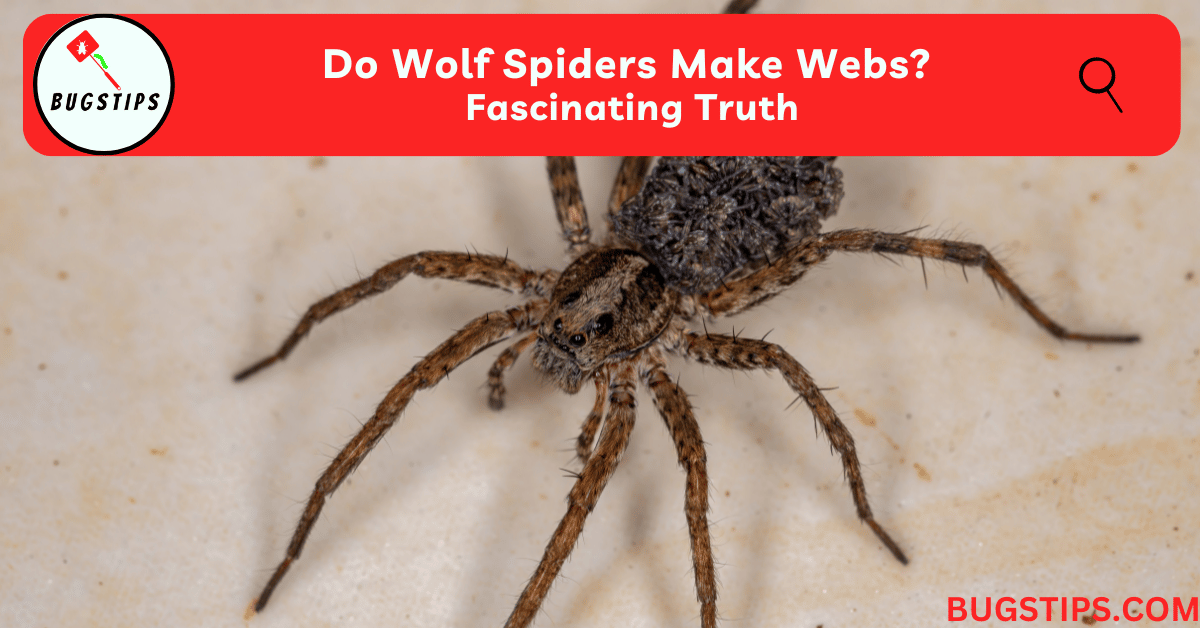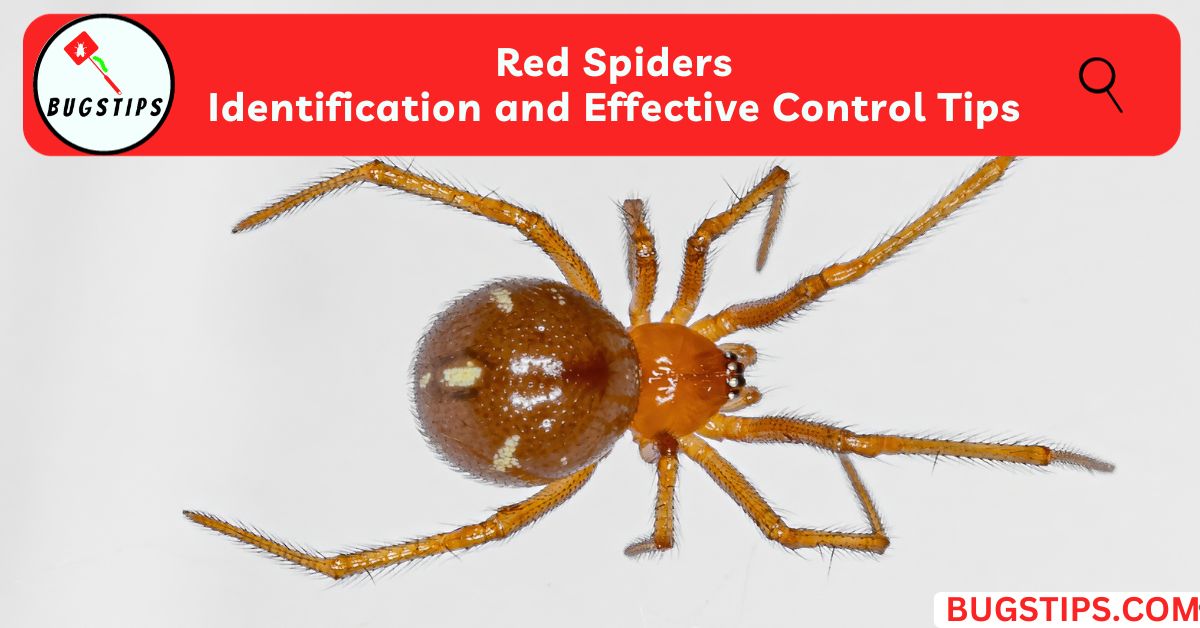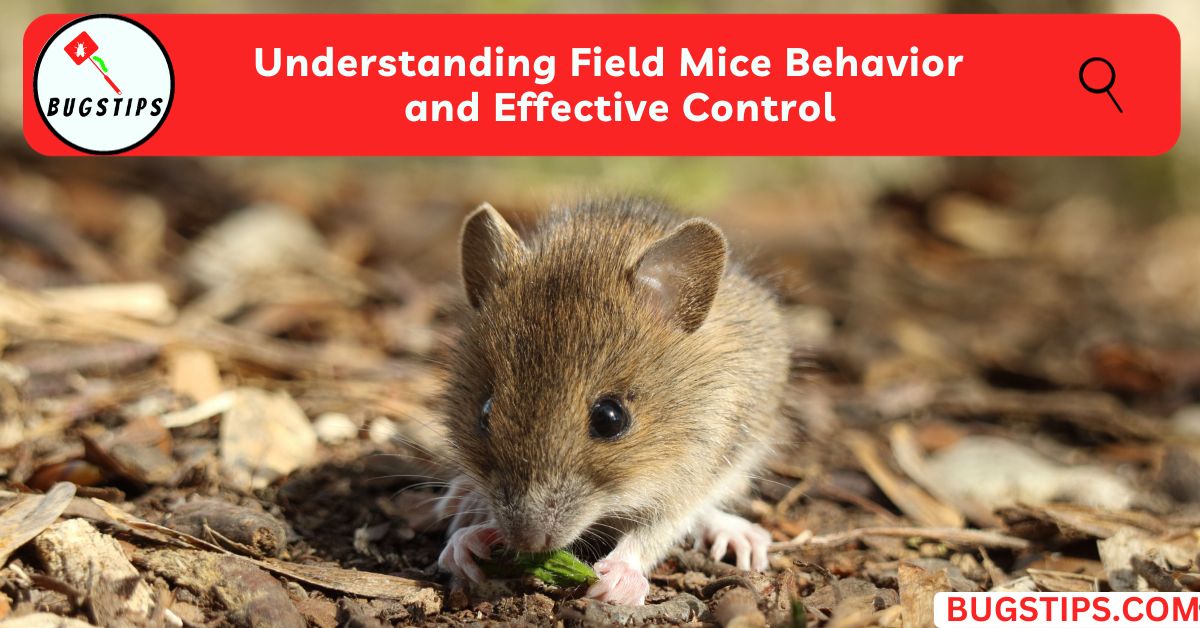This post may contain affiliate links which means as an Amazon Associate, this site may earn a small commission on qualified purchases made through links at no extra cost to you. Learn more on Affiliate Disclosure
When we think about spiders, the first thing that often pops into our heads is their intricate webs.
But did you know that not all spiders are into web-making? Wolf spiders are a prime example of this.
In this article, we’ll answer the question, “Do wolf spiders make webs?” in detail. We’ll also explain how these spiders catch their prey without using webs.
Plus we’ll delve into their interesting hunting methods, how they use their special silk, where they find their homes, and other cool facts about them.
So, if you’re curious, keep reading to learn all about these fascinating wolf spiders.
Do Wolf Spiders Make Webs?

No, wolf spiders do not make webs like many other spider species.
They rely on different hunting methods and do not construct elaborate webs to catch their prey.
Wolf spiders are active hunters that use their agility and keen senses to locate and capture their food.
Instead of relying on webs, they rely on their speed and hunting abilities to pursue and capture their prey directly.
You May Also Like – Zombie Spiders | The Creepy Truth
How Do Wolf Spiders Hunt?
Wolf spiders employ a unique and active hunting strategy. They are not web-builders like some other spiders but instead rely on their exceptional hunting abilities to capture their prey.
Here’s a closer look at how wolf spiders hunt.
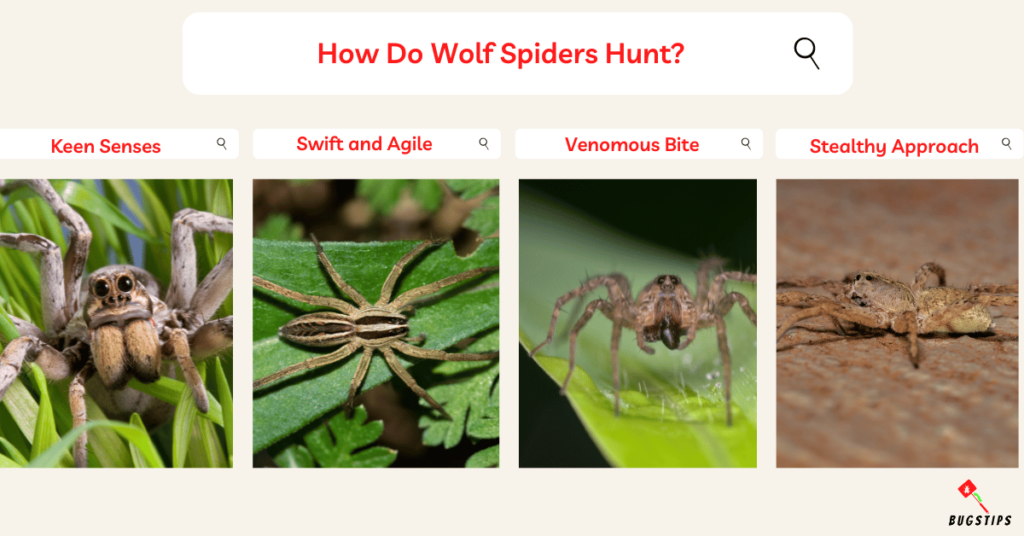
Keen Senses
- Wolf spiders have excellent eyesight, allowing them to detect and track their prey with precision.
- Their vision helps them spot movement and identify potential targets.
You May Also Like – Are Banana Spiders Poisonous?
Swift and Agile
- Wolf spiders are built for speed.
- Their bodies are streamlined, and they have strong, agile legs that enable them to chase down their victims.
- When they locate a potential meal, they pounce with impressive accuracy and speed, seizing their prey before it can react.
Venomous Bite
- Once a wolf spider catches its prey, it delivers a venomous bite.
- This venom not only immobilizes the prey but also starts to break down the internal tissues, making it easier for the spider to consume its meal.
Stealthy Approach
- Wolf spiders use a combination of patience and stealth to get close to their prey.
- They stalk their victims, using their surroundings as cover, and then launch a surprise attack when the time is right.
Many wolf spider species are active at night, utilizing their excellent night vision to navigate and hunt. This adaptation helps them avoid the heat of the day and potential predators.
You May Also Like – Bugs in Mailbox: 10 EASY Ways to Keep Them Out
Do Wolf Spiders Spin Any Silk?
wolf spiders do spin silk, but they do not use it for constructing intricate webs like other spider species.
Instead, they utilize silk for various purposes in their daily lives.
Here are some ways in which wolf spiders make use of silk.
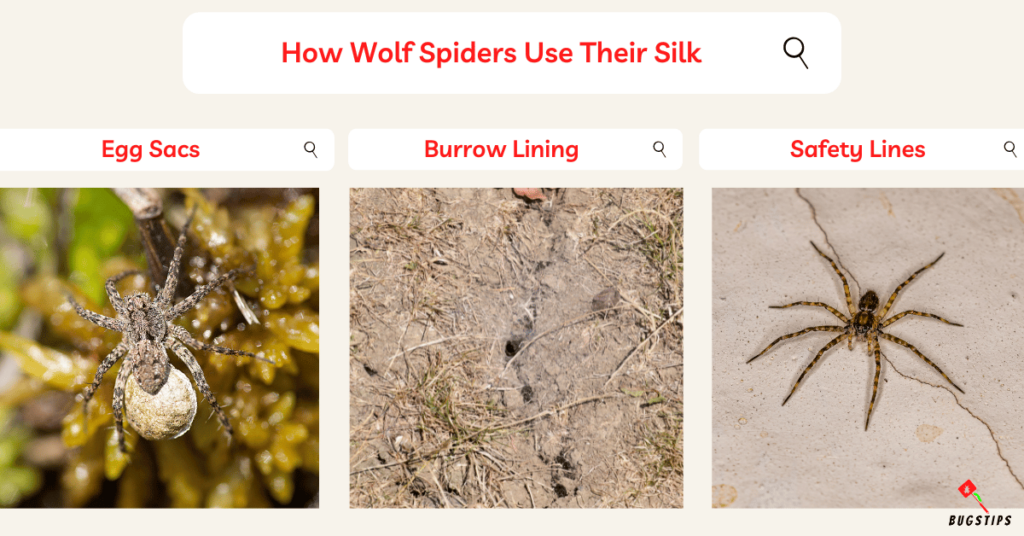
Egg Sacs
- One of the primary uses of silk for wolf spiders is in the creation of egg sacs.
- Female wolf spiders construct protective egg sacs from silk, where they deposit their eggs.
- These silk sacs safeguard the eggs from potential threats and provide a suitable environment for their development until they hatch.
Burrow Lining
- Wolf spiders might also use silk to create shelters or retreats.
- These shelters offer protection from predators and harsh weather conditions.
- They might fashion silk-lined burrows or hide in crevices, using their silk to reinforce these safe spaces.
Safety Lines
- While not utilized for webs, wolf spiders sometimes create silk safety lines to prevent them from falling.
- These lines are especially handy when they’re hunting on surfaces like leaves or bark, offering a lifeline if they lose their footing.
Related Article – Does Lavender Repel Spiders?
If Wolf Spiders Don’t Build Webs, Where Do They Sleep?
Wolf spiders do not construct webs for sleeping purposes. Instead, they seek shelter in various locations that provide protection and camouflage.
Here are some common places where wolf spiders are known to rest.

Burrows
- As explained above wolf spiders often create burrows in the ground as their primary shelter.
- These burrows serve as a safe retreat where they can rest, molt, and lay eggs.
- The burrows provide protection from predators and adverse weather conditions.
Leaf Litter
- In wooded areas, wolf spiders may seek refuge under leaf litter or dense vegetation.
- They can find shelter and camouflage among the fallen leaves, allowing them to rest undisturbed.
Rocks and Logs
- Wolf spiders may take refuge under rocks, logs, or other natural debris.
- These objects provide crevices and hiding spots where they can rest and remain concealed during the day.
Bark and Tree Trunks
- Some species of wolf spiders are adept climbers and may seek shelter on tree trunks or under bark.
- They can find crevices or gaps in the bark where they can rest and blend in with their surroundings.
Related Article – Does Windex Kill Spiders? An Expert Analysis
Spiders That Don’t Make Webs
There are several spider species that have evolved different hunting strategies and do not rely on web construction for capturing prey.
Here are a few examples of spiders that fall into this category.

Wolf Spiders
- As mentioned earlier, wolf spiders are agile hunters that actively pursue their prey.
- They use their excellent eyesight and quick reflexes to chase down and capture their victims.
- Instead of constructing webs, they rely on their hunting prowess and agility to catch their food.
Jumping Spiders
- Jumping spiders are known for their exceptional jumping abilities.
- They have keen eyesight and use their remarkable vision to locate and stalk their prey.
- Jumping spiders rely on their agility and precision leaps to catch insects and other small creatures, rather than weaving webs to trap them.
You May Also Like – Do Spiders Poop? The Truth Behind Arachnid Waste
Fishing Spiders
- Fishing spiders, as their name suggests, are skilled hunters in aquatic environments.
- They are equipped with specialized traits that enable them to walk on the water’s surface, and they use vibrations to detect prey in the water.
- Fishing spiders catch their prey by quickly grabbing it with their front legs, rather than relying on webs.
Crab Spiders
- Crab spiders are ambush predators that do not build webs.
- They have the ability to change their body color to blend in with their surroundings, allowing them to hide and wait for unsuspecting prey to come near.
- When the opportunity arises, crab spiders strike and capture their victims without the need for a web.
These are just a few examples of spiders that don't make webs. In addition to the ones mentioned, there are other spiders like Tarantulas and Yellow Sac Spiders that also do not rely on web-building for hunting.
You May Also Like – 5 Bugs with Lots of Legs | Ultimate Info Guide
Do Wolf Spiders Live in Groups?
Wolf spiders do not typically live in groups or colonies. They are generally solitary creatures and prefer to live and hunt alone.
Each wolf spider establishes its own territory, which it defends against other individuals of the same species.
This territorial behavior helps to minimize competition for resources and potential conflicts.
Mating is one of the few instances where wolf spiders come together temporarily. Male wolf spiders may enter the territory of a female in search of a mate.
However, once mating is complete, they usually go their separate ways.
It’s important to note that while wolf spiders prefer a solitary lifestyle, they may occasionally be found in close proximity to one another, especially in areas with abundant food sources or suitable habitats.
However, this proximity does not indicate social behavior or group living patterns.
Related Article – Do Spiders Feel Pain?
Can Wolf Spiders Jump?
Wolf spiders have the ability to jump. They are known for their impressive jumping capabilities compared to many other spider species.
While they may not jump as far as some other jumping spider species, they are still capable of making remarkable leaps considering their size.
Wolf spiders use their powerful leg muscles to generate the force needed for jumping.
When they spot prey or sense a potential threat, they can quickly propel themselves forward using a spring-like motion.
This allows them to cover short distances and close in on their target or escape from danger.
While wolf spiders can jump, they primarily rely on their exceptional agility and speed for hunting and capturing prey. Jumping is just one of the many adaptations they possess that contribute to their effectiveness as hunters.
You May Also Like – Do Ticks Die in the Winter?
Final Thoughts
It is clear that wolf spiders do not make webs like many other spider species. Instead, they rely on their agility and hunting abilities to capture prey.
While they do produce silk, it serves different purposes such as lining their burrows and creating protective egg sacs.
Wolf spiders showcase the diversity of spider-hunting strategies and their ability to adapt to their environments.
They are skilled predators that rely on speed and precision rather than web-building to secure their meals.
FAQs
What spiders don’t make webs?
Wolf spiders, jumping spiders, fishing spiders, and crab spiders are examples of spiders that do not make webs.
Do wolf spiders make webs on the end of tree limbs?
No, wolf spiders do not spin webs on the ends of tree limbs. They don’t build intricate webs like other spiders.
Where are wolf spiders found?
Wolf spiders are found worldwide in various habitats, including forests, grasslands, deserts, and even inside homes.
Are wolf spiders poisonous to humans?
While wolf spiders possess venom, they are generally not considered dangerous to humans. Their bites may cause localized pain and swelling, similar to a bee sting.
Do wolf spiders spin any silk?
Yes, wolf spiders spin silk for various purposes such as lining their burrows, creating egg sacs, and as draglines for safety.
What Do Wolf Spiders Eat?
Wolf spiders primarily feed on insects like ants, beetles, crickets, and other small arthropods.
Can I keep a wolf spider as a pet?
While some people keep wolf spiders as pets, they require specialized care and may not be suitable for everyone. It is important to research their specific needs before considering them as pets.
Can wolf spiders climb walls?
Yes, wolf spiders are capable climbers and can scale walls and other vertical surfaces.
How long do wolf spiders live?
The lifespan of a wolf spider varies depending on the species, but on average, they can live for a couple of years.
What looks like a wolf spider but has a web?
Funnel-web spiders or grass spiders may resemble wolf spiders in appearance but construct funnel-shaped webs to catch their prey.
Resources – (for further reading)
Live Science – Wolf spiders: Behavior, bites and other facts
The Australian Museum – Wolf Spiders

